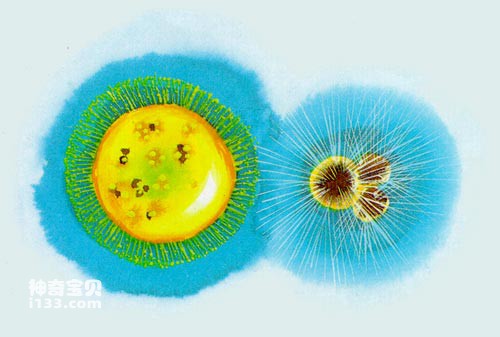Radiolarians are single-celled protozoa floating in the ocean. They are named after their radially arranged thread-like pseudopods.
Protozoa are the lowest type of animals, and each individual is composed of only one cell. In terms of classification, scientists classify them into one phylum, namely Protozoa. But this single cell of a protozoa is a complete organism, with the main life functions that an individual animal should have. Each part of the cell differentiates, each responsible for a certain function, forming an "organoid". Protozoa often have flagella, cilia or pseudopods as their locomotion organs. Some protozoa have a skeleton or a solid shell in their cytoplasm.

Radiolaria
Individual protozoa are very tiny, generally less than 250 microns, that is to say, they are less than 1/4 of the size of a 1 mm long rice grain. Such a small body can only be observed under a microscope.
However, these inconspicuous little animals are widely distributed. Most of them live in the ocean or freshwater waters, and some live in moist soil or live a parasitic life.
Scientists divide these animals into four classes based on whether they have locomotive organs or what types of locomotive organs they have: Giardia, Ciliates, Sporozoa and Sarcopoda.
Radiolarians belong to the class Sarcopodia. The main difference between them and other protozoa is that there is a chitinous central capsule in the cytoplasm, which divides the cytoplasm into two parts: extracystic and intracystic parts. The surface of the cyst is covered with a cuticle membrane, and there are small holes in the membrane to allow the cytoplasm inside and outside the cyst to communicate with each other.
Radiolarians have various shapes such as spherical and bell-shaped, and their body diameter can reach 100 to 2500 microns. The skeleton secreted by the cytoplasm is usually contained in the cell, and its chemical composition varies with different types. Most of them are silicon or silicon containing organic matter, and a few contain strontium carbonate. There are three types of radiolarian skeletons: one is a loose structure, the skeleton is composed of rods, spicules and spines that are not connected or jointed firmly; the other is a tennis ball structure, the skeleton is spherical, spindle or cone-shaped, with edges along the The central capsule is tightly connected to form a network; there is also a concentric structure, the skeleton is composed of multiple layers of concentrically arranged grids, and there are often many needles, hooks, and columella connected between each layer to form an exquisite and beautiful shell shape. Based on these different skeleton structure types, and to a certain extent combined with the structural characteristics of the centrocyst, scientists have divided radiolaria into three suborders, namely the Acanthozoa suborder, the Polycystozoa suborder and the Phaeocystis suborder . Among them, the suborder Polycystis is divided into two categories: foam worms and cage worms.
Radiolarians live a floating life and like the ocean environment. They are geographically widely distributed, covering almost all sea areas in the world. Most radiolaria are distributed in warm seas, and radiolaria near the equator are especially abundant and diverse. There can be up to 40,000 radiolaria living in seawater (about half a cubic meter) that can be filled in an ordinary bathtub! In the waters near the North and South Poles, radiolaria also flourish along with diatoms. Scientists have divided radiolaria in modern oceans into typical surface combinations according to distribution types: polar zone, subpolar zone, subtropical zone, and tropics. Due to changes in physical and chemical conditions at different water depths under the sea surface, radiolaria also show different combinations at different water depths. Acanthozoa and foam worms are usually restricted to the photic zone, while cyprinids and phaeocystis live at depths of more than 2,000 meters below the sea surface.
After the radiolarians died, their siliceous shells sank to the seafloor and were not easily dissolved, so they accumulated in large quantities. The density was so amazing that the number of individuals in a matchbox-sized (approximately 2 cubic centimeters) sediment contained more than 120,000 individuals. These radiolarian shells accumulated on the seafloor formed the famous radiolarian ooze, which covers 3.4% of the entire earth's seafloor area.
The life history of radiolaria is very long. However, because the bones of the suborders Acanthozoa and Phaeocystis are weakly bonded, they are easily damaged and difficult to preserve as fossils. Therefore, most of the radiolarian fossils commonly found in the strata belong to polycystia. suborder. They appeared in the Cambrian period and reached their peak in the late Devonian and Carboniferous periods. France, Britain, the Ural region of Russia, North America and Australia are rich in radiolarian fossils. In the Paleozoic Era, there were many representatives of foamy worms. For example, in the radiolarian rocks found in the early Permian strata of the Renhua area in Qujiang County, Guangdong Province, my country, the fossils mostly belong to the foamy worms.
By the Mesozoic Era, both types of polycystia were discovered. Triassic radiolarian fossils are relatively rare, but both foamy worms and caged worms have been found in the siliceous rocks of the late Triassic strata near Mount Everest in my country. In the Jurassic and Cretaceous periods, radiolarians developed to a new level, with shell shapes becoming more complex and many new types appearing, distributed in the Tethys Sea and the Pacific.
The Cenozoic Era is the peak period of radiolarian development, especially in the Eocene and Miocene, when all groups of radiolarians appeared and were widely distributed around the world, forming many representative fossil groups. The zoning of Tertiary strata by some scientists is based on radiolarian fossils.
animal tags: radiolaria
We created this article in conjunction with AI technology, then made sure it was fact-checked and edited by a Animals Top editor.